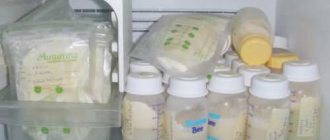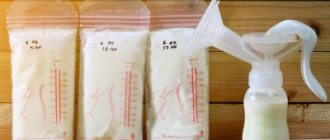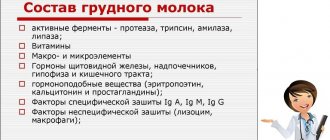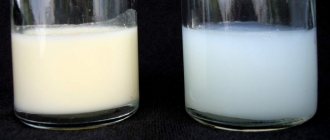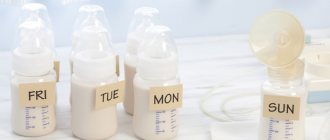8 Jul 118074
Rada Melnikova, breastfeeding consultant, member of the SPPM, graduate of the ProgV Project www.progv.ru : You can still sometimes hear advice to a young mother to express her breasts “dry” after each feeding. The most varied arguments are given: so that the milk does not disappear, so that there is no stagnation, “I did this, and only thanks to this I fed it!” Indeed, in the middle of the last century there were such recommendations. There was a good reason for them: after all, another recommendation was widespread at that time - scheduled feeding. The baby was put to the breast 6-7 times a day with a long night break. As a rule, one feeding is one breast, so the baby was attached to each breast 3-4 times a day. Feeding at such a rhythm is critically insufficient stimulation of the breast for milk production. Regular pumping in this case made it possible to at least somehow support lactation.
If the mother feeds the baby on demand day and night, does not limit the duration of feedings, latches to the breast for 12 days or more, the baby gains weight and develops according to age standards, then there is no need for additional pumping!
Milk production is a law of supply and demand: the more milk is removed from the breast, the more milk is produced, and vice versa. If a mother regularly pumps her breasts, the body perceives this as a signal that the baby needs more milk than he actually sucks. This can easily lead to hyperlactation, and too much milk is no more pleasant than its lack, and can lead to stagnation, inflammation in the mother, and digestive problems in the child.
Difficulties with breastfeeding may occur if
- you need to go to work, study or run errands;
- the child is premature or has diseases that prevent sucking;
- the breast is hard and full - it is difficult for the baby to suck;
- it hurts to feed because of cracked nipples;
- the mammary gland is inflamed (mastitis);
- you have been temporarily prescribed the necessary medications; they are contraindicated while breastfeeding;
In all these cases, pumping helps maintain or establish breastfeeding.
Tips for Expressing More Breast Milk
If you are faced with the task of collecting as much breast milk as you want, then try the following:
Pump as often as your baby feeds.
Usually this is once every 3 hours (or more often - approx.). If you're worried about whether you have enough breast milk, breastfeed more often . Frequency stimulates the milk ejection reflex more effectively than increasing the time of each pumping.
Add another pump early in the morning.
Early morning is when you produce the most breast milk. If you're trying to build up a "strategic stock" in your freezer, this is a good time of day to achieve your goal.
Check your breast pump.
Sometimes the most effective advice is the most obvious. Have you assembled the device correctly? Is the bolt or any other parts worn out? Check with the manufacturer (the phone number can be found in the instructions). If you purchased or rented a breast pump from a lactation consultant or La Leche League leader, she may be able to advise you on replacing worn parts.
Try pumping one breast while your baby nurses on the other.
The baby will trigger the milk release reflex and it will be easier for you to collect milk from the other breast. (This is easiest to do with an electric breast pump rather than a manual one)
Double pumping.
For most women, double pumping (from both breasts at the same time) is the most useful recommendation, because... this usually results in more pumping. Prolactin levels in the blood are also higher if you stimulate both breasts at the same time. The best and easiest way to do this is to use good quality electric breast pumps, but some manual ones can be operated with one hand. Get 2 of these breast pumps and you can double pump manually.
If pumping is not going well, try a different breast pump.
It is best if you try a breast pump that is an order of magnitude, or even two orders of magnitude, better quality than the one you are using. Rent a clinical unit for a week or two. You might be surprised by the difference! (Some women express more effectively by hand. We do not recommend that everyone use exclusively clinical breast pumps, as it may seem from the text - approx.)
How often should I pump?
To maintain or increase lactation, express regularly. The more often you empty your breasts, the more milk you will produce. It is formed “on request”. This is regulated by 2 hormones: prolactin and oxytocin.
The first one “releases the plan” to the mammary gland for milk, depending on how much was needed last time. Oxytocin allows stored milk to flow from the breast in response to nipple traction - this is called the oxytocin reflex.
How to signal to your body how much nutrition you need to create for your child?
If you don't have enough milk, pump every hour for the first few days. Then you need to express as often as the baby would like to eat: usually every 2-3 hours. This regimen is also suitable for maintaining lactation. At night you can take a break for 4-6 hours.
How long can I use expressed milk? Look at the table. It refers to milk collected in a sterile container. Write the date of collection on the container.
Why pump your breasts?
Often, a nursing mother faces a difficult dilemma - to listen to the advice of previous generations (express breasts after each feeding) or follow the recommendations of doctors who claim that, by modern standards, it is better to express milk in exceptional cases. After all, the procedure itself is not very pleasant for a young woman, and often even causes pain. So is it necessary to express milk? Any breastfeeding consultant will answer that it depends on the situation, since there are cases when a nursing woman cannot do without pumping.
Cases when pumping is not necessary
- In the first days after birth. It is not correct to think that as soon as a baby is born, the mother’s breasts are already filled with milk. No, at first only colostrum arrives, and the milk itself comes only on the third day. Therefore, it is not necessary to massage or stimulate the breasts; food that is beneficial for the newborn will not appear faster. There is a time for everything; it is better to replace pumping these days with extra latching of the baby to the breast.
- If the baby is reluctant to take the breast. Small children are very lazy and cunning from birth; if a nursing mother supplements her baby’s feeding from a bottle, then over time the baby will try to drink only from it, forgetting about the mother’s breast. This makes it easier for him to eat and the formula is often much sweeter than breast milk. Therefore, mothers who have little milk or whose baby has difficulty latching onto the nipple should not give their baby a bottle on demand or express milk. It is better to put the baby to the breast more often and try different feeding techniques.
- With stable lactation. If the child eats on average every 2-3 hours, is full and behaves calmly, then the milk comes in normally and the baby has enough of it.
When is pumping necessary?
It is necessary to express excess milk in the first week after birth, when the baby is just getting used to milk. At this point, too much of it arrives and it is better to express it as needed up to several times a day only until the breast condition improves. But you need to know in moderation in everything - you don’t need to pump after every feeding, this will cause even more milk to come in. Over time, the baby will adjust his feeding schedule and milk volume.
The second reason why it is better to remove excess milk from the mammary glands is lactostasis. With this unpleasant disease, due to blockage of the milk ducts in the female breast, unnecessary seals are formed, which can subsequently cause fever and pain.
To prevent the development of mastitis, milk in case of lactostasis must be expressed manually.
And in the future, when the lactation process is established, you can stop pumping and make sure that the baby completely sucks out the accumulated milk.
Sometimes you have to resort to pumping during a mother’s illness, when a nursing woman is forced to take strong medications or antibiotics. To maintain milk production, it is necessary to express your breasts up to 10 times a day, then after completing the course of taking medications, the mother will be able to continue feeding.
In order to give the premature baby all the necessary substances, it is also worth expressing milk and feeding the baby from a bottle. In such a situation (if it is not possible to put the baby to the breast immediately after birth), you should resort to emptying the breast 6 hours after birth, first strain the colostrum, and then all the arriving milk.
A woman has to resort to pumping in exceptional cases, for example, with lactostasis, taking potent drugs, or if the baby is premature.
When not to pump
You shouldn’t pump after every feeding, as they used to say, “until the last drop.” A healthy female body produces exactly as much milk as a newborn can eat. The older the baby gets, the more milk he consumes and the more milk he receives. Excessive pumping will lead to excess milk at the next feeding, which in turn can lead to complications for women's health. In addition, there are categorical cases when natural feeding, and, accordingly, pumping, is not acceptable:
- if contraindicated by the child. These are diseases of the following nature: individual lactose intolerance, leucinosis, abnormalities in the development of the gastrointestinal tract or phenylketonuria;
- with contraindications from the mother. There are several categories here: when breastfeeding is prohibited (AIDS, HIV infection, hepatitis), when feeding can be continued after the disease has been eliminated (viral herpes, prescription of psychotropic, radioactive or iodine-containing drugs, as well as severe forms of illness when there is no way to care for the newborn , oncology treatment) and when breastfeeding should be treated with great caution (inflamed breasts, tuberculosis, drug use).
In severe cases, the decision on feeding is made collectively, by several doctors at the same time.
How long can expressed breast milk be stored and how to store it correctly
— at room temperature for 4 hours; — in the refrigerator at a temperature of 4 ± 2°C for no more than 24 hours; — in the freezer at -18°C for 3–12 months. (optimally no more than 3 months).
Tiunova Elena
K.M.N., pediatrician of the highest category, nutritionist
“Pour out the breast milk after pumping if you were prescribed medications during breastfeeding that are contraindicated for breastfeeding.”
If you need to make your breasts softer for comfortable feeding, then you decide how much to express. How to start the process?
Contraindications to pumping
Feeding a child with expressed milk is prohibited if the mother suffers from HIV infection or an open form of tuberculosis, and is also taking medications whose use is contraindicated during lactation.
Other prohibitions regarding the procedure:
- You should not express milk more than three times a day, especially if the mother continues to put the baby to the breast. Such cases are characterized by an increase in milk production and the development of complications, the main of which is lactostasis. If a woman does not put her baby to her breast, the number of pumpings should correspond to the number of feedings, i.e. about 8 times a day (every 3 hours);
- It is prohibited to carry out the procedure immediately after breastfeeding for the same reason. This is fraught with hyperlactation, i.e. increased milk production;
- You need to stop pumping at the moment when a feeling of relief arises in the chest. Do not squeeze out the milk to the last drop. For the body, this will be a signal that the child does not have enough food, and he will begin to produce it in large quantities;
- Usually, when lactation begins, a lot of milk is produced, and women resort to pumping. However, this can only be done if the breast is too dense and it is uncomfortable for the newborn to suck on it. Again, you cannot express all the milk, as this will complicate the situation;
- It is forbidden to carry out the procedure at night, because at this time of day a large amount of prolactin is produced - the hormone responsible for the formation of milk. Regular nightly pumping can cause stagnation.
How to stimulate milk flow faster without a baby?
- make yourself comfortable;
- think about how you are currently caring for your baby;
- while pumping, look at him or hold his clothes in front of you;
- drink a warm drink (not coffee) or take a warm shower;
- massage your nipples by rolling them between your thumb and forefinger, or gently massage your breasts;
- if you have an assistant, ask her to give you a back massage. It is carried out like this: you sit at the table and lean forward, leaning on your elbows. You lower your head. Your assistant clenches her hands into fists, leaving only her thumbs. She spends 2-3 minutes running her thumbs on either side of the spine. The movement is made from top to bottom from the neck to the shoulder blades.
If you're upset that you now have to pump, find support. This will be someone who will listen and encourage you. An upset state also interferes with the free flow of milk: take care of your good mood. In any case, you do everything in your power for the baby.
So, you felt a rush of milk. Now start expressing milk into a bottle. Follow the rules for expressing milk, and you won’t get hurt. With mastitis, unpleasant sensations are possible that are associated with the inflammation itself.
It is important!
Expressing breast milk by hand gives about the same results as using a breast pump. Which is better depends on your feelings and convenience for you.
WHEN TO EXPRESS. EFFECTIVE SCHEMES.
There is no single algorithm here either; a lot depends on the situation. The general principles are as follows.
1. If the baby is attached to the breast, then you need to express immediately AFTER feeding or 30-40 minutes after it (that is, between feedings), and not before. There are situations when it is acceptable and even necessary to express before feeding, but these are special cases and should be recommended by a specialist. In the vast majority of cases, it is advisable to express after the baby has fed well from the breast.
2. It is very effective to express one breast while feeding the other breast, since the baby stimulates the flow of milk in both breasts by sucking.
3. The most effective pumping mode is “5+5…1+1”: first 5 minutes on one breast, then 5 minutes on the other, then 4 minutes on each breast, then 3, 2 and finally 1.
4. Simultaneous expression of both breasts also stimulates milk secretion and milk production very well (this can be done either with a breast pump designed for simultaneous expression, or manually, after some training).
5. Usually one pumping session takes 15-20 minutes for each breast. If you are working to increase your milk supply, continue pumping for another 2-3 minutes after your milk has stopped coming out.
6. Sometimes mothers combine two types of pumping - first they express with a breast pump, and then a little more with their hands. This often allows you to express more milk.
7. Don't think too much about expressing a lot of milk. Practice shows that if a mother expresses without looking into the container or counting milliliters, she manages to express more milk.
IMPORTANT! The baby creates a stable vacuum and performs a whole range of movements (almost all facial muscles are involved in the sucking process) to extract milk. When expressing by hand or with a breast pump (even the best), it is impossible to completely imitate the baby’s actions. Pumping is a skill! The volume of expressed milk cannot judge whether the mother has enough milk.
How to express milk by hand
So, you washed your hands with soap and feel a rush. What's next:
- Sit comfortably, bring the jar closer to your chest.
- Place your thumb on top of your chest, directly above the areola.
- The index finger and the other fingers behind it are under the areola, opposite the thumb.
- Rolling your thumb and forefinger along the surface of your chest, lightly press on your chest and immediately release the pressure. You cannot rub the skin or slide on it. Press gently on your breasts: too much effort will prevent milk from coming out at all.
- Press and release. The milk comes out gradually: be patient and confident.
- Change the position of your fingers. Now place them on the sides of the areola opposite each other.
- Press and release again.
- After 5-6 minutes, when the milk flow slows down, move to the other breast.
- When you have emptied the second breast, go back to the first or now try expressing from both at once.
- If you express very little milk, you can reduce the procedure time, but do it more often.
How to Make Expressing Breast Milk More Comfortable
Try these few tips to make the process easier and more convenient.
Wear two-piece clothing for easier access to your breasts.
One of the tricks that makes life easier for mothers is to wear comfortable clothes. It's easiest to pump (just like breastfeeding) if you wear a loose top that can be removed separately from the bottom. There are cute and comfortable nursing clothes on sale with special hidden holes for the breasts.
Lean forward while pumping.
This will prevent milk drops from getting on your clothes.
Double pumping with one hand.
Try leaning over the table to hold the breast pump using the edge of the furniture, and use one hand to hold the flanges of the breast pump on your chest. Your second hand will be freed up for flipping through the pages of a magazine or eating. Or try using a footrest or thick book to elevate your knees so that you can rest the collecting bottles on your knee as you lean forward.
Original: https://www.askdrsears.com/topics/feeding-eating/breastfeeding/while-working/19-tips-better-pumping
Translation by Maria Lobas for “Milk Mother”
How to Express with a Breast Pump
Do you feel uncomfortable expressing with your hands? Use a breast pump:
- Make sure your breast pump is thoroughly washed and dried.
- Wash your hands with soap.
- Induce milk let-down using one of the methods described above.
- Place the breast into the breast pump funnel, with the nipple strictly in the center. Choose the size of the funnel according to your bust size.
- If it is a mechanical model, press down on the device that extracts the milk. In the electric model, select the desired operating mode: when you are not in pain and the milk is flowing. For optimal speed, start with the lowest power setting. Increase until the first signs of discomfort appear; after they appear, reduce the vacuum level by one notch.
- If the milk does not come out within 5 minutes, try again a little later.
- A breast pump should not be used for cracked nipples.
Expressing with a breast pump.
1. Read the instructions carefully: is the breast pump assembled correctly, are the parts in contact with the breast and milk clean?
2. It is important to choose the nozzles that exactly match the diameter, otherwise milk may be expressed painfully or ineffectively, and cracks or swelling of the nipples may occur.
3. If the breast pump has several power levels, start with the minimum to avoid nipple injury, and then gradually increase the power until it is comfortable, but not painful.
4. Stop pumping immediately if it hurts! Further:
- make sure that the nipple is exactly in the center of the nozzle and that it is the right size for you,
- reduce power,
- Don't pump for too long, take breaks.
Types of breast pumps, their advantages and disadvantages
They are:
- Manual mechanical ones are silent, but require skill. To create a vacuum that pumps out the milk, a piston, syringe or bulb is used.
- Electric ones will do everything for you, but they will make noise during the milk extraction process. Some models also have a mode that stimulates the tide. Powered by mains and batteries.
Learning to express milk takes patience and time. WHO recommends that all new mothers learn at least how to pump manually. This way you will ensure the best nutrition for your baby under any circumstances.
When should you express milk?
- Birth of a premature baby. Babies born prematurely may not have a developed sucking reflex, and their need to receive mother's milk is perhaps even higher than that of full-term babies. After all, he must quickly gain strength and make up for everything that he did not have time to do, being born earlier.
- Poorly developed sucking reflex. Such children fall asleep during feeding, swallow rarely, are lethargic, and in some cases may refuse to breastfeed.
- Insufficient lactation. It can be observed both from the first days and appear after some time.
- Establishment of lactation. Immediately after childbirth, the mother begins to produce colostrum, which, despite its small volume, is nourishing and very healthy. After colostrum comes milk, the amount of which is usually too large for a newborn. At this stage, it is important that the overfilled breasts be emptied so that the already stronger baby will have enough milk in the future. There is no need to be fanatical here, expressing everything to the last drop; it is quite enough if you feel that the breasts have become soft and the feeling of fullness in the chest has gone away.
- Stagnation of milk (lactostasis), which threatens the development of mastitis. It can be caused by various reasons, including improper pumping. It is observed in individual lobules of the breast due to blockage of the ducts leading to the nipple. In this case, milk is expressed from separate lobules of the mammary gland that have hardened from excess milk.
- Taking medications that can be passed on to the baby through breast milk. Expressing in this case serves as a tool to maintain lactation in the future. Expressed milk has to be thrown away. At this time, the baby eats formula, unless the mother, knowing about the upcoming medication, has not prepared expressed milk in advance.
- Inverted or flat nipple. Before you start pumping for this reason, you should try using special breast pads and if nothing works out, start pumping.
- The child is separated from his mother. The need is quite understandable, because if the mother works, is forced to leave for several hours, or if the child is undergoing treatment without the mother, the child cannot be left without breast milk, especially since lactation may decrease with regular separation.
Recommendations before pumping
Regardless of which pumping method you use, to increase its effectiveness, you need to remember some simple rules.
- if possible, sit next to the baby, let him touch the breast - this will release more milk;
- if the baby is not around, look at his photo, think about him;
- 10-15 minutes before pumping, drink a warm drink;
- take a warm shower or apply a towel soaked in warm water to your chest;
- Do a breast massage using one of the options suggested below.
1 massage option
Sit comfortably and do a light, pressure-free chest massage. To do this, first make circular movements with four fingers from the edge of the breast to the nipple (Fig. 1), and then stroking the mammary gland along the flow of milk (Fig. 2). Such movements will help the movement of milk even through the narrowest ducts. Areas with compactions are massaged with spiral stroking and finger tapping. At the next stage, it is necessary to form the nipple by first squeezing the isola (Fig. 3), and then, as if stretching the nipple itself with your fingertips (Fig. 4).
2 massage option
Place the mammary gland between two palms and, bringing your palms together, gently squeeze it. Next, use your fingers to smoothly move your breasts, first away from the armpit and then towards it. Return to the original position and grab your chest, squeezing lightly with both palms, as shown in the last picture.
As soon as the milk begins to flow out, you can start pumping.
Storing expressed breast milk
Like any food product, expressed breast milk has its own storage characteristics, if not observed, it can not only lose its beneficial properties, but also become harmful.
Breast milk storage containers
They can be made from various materials, the main thing is that they are clean and tightly closed. Modern mothers highly value convenience and ease of use in purchased containers for storing breast milk, in particular the volume corresponding to one dose of feeding, the presence of a measuring scale, and tags where you can indicate the date and time of pumping. In appearance, these can be bags, containers, bottles. For freezing, the ideal option is bags that will not burst when frozen like glass or plastic containers.
Milk storage bags
Milk storage containers
Milk storage bottles
However, not everything is so simple from a security point of view. Glass containers and special polymer bags for storing milk are considered the safest to use. If you still choose plastic containers, you should definitely pay attention to their suitability for storing, freezing and heating milk. To do this, you need to determine the material from which they are made. This information, as a rule, is always contained at the bottom of the container in the form of a triangle with a number in the middle and other additional images.
To store expressed milk from all types of plastic, it is best to prefer polycarbonate dishes (number 7) and polypropylene dishes (number 5). Moreover, on polycarbonate dishes there must be an additional symbol “Bisphenol A free” or “BPA free” or “0% BPA”. This means that bisphenol A was not used in the manufacture of polycarbonate, which tends to transfer from plastic to products during long-term storage or heating. In conclusion, it must be said that it is not necessary to sterilize reusable milk storage containers. It is quite enough if they are washed well by hand or in the dishwasher. Instead of using detergent, you can pour boiling water over the container.
At what temperature should it be stored?
Human milk has the unique ability to inhibit the growth of bacteria for a long time, so if after 4-6 hours you plan to feed your baby with it, then it is not necessary to put it in the refrigerator, unless of course the room is cool. Storing milk for several days requires the use of a refrigerator, and an even longer freezer.
When to Express Breast Milk
There are situations when there is an urgent need to express after each feeding, these are:
- congestion in the mammary gland;
- lack of secretion produced by the glands to feed the baby or insufficient lactation;
- the need to maintain lactation during a forced break from breastfeeding;
- creating a “bank” of milk to feed the child during the mother’s absence.
With stagnation of milk in the breast
If during previous feedings the mammary gland was not completely emptied, one of the milk ducts became clogged , and the corresponding segment of the breast swelled - lactostasis has already formed. In this case, doctors recommend urgently starting to express, so as not to provoke the development of mastitis. This will have to be done every one and a half to two hours and only with your hands. You should massage your breasts carefully, because any touch to the affected area causes pain. During stagnation, you need to express breast milk by hand until the lump decreases and the condition eases, but not longer than 25-30 minutes.
To increase lactation
If you see that the child is nervous under the breast and does not eat enough, it is worth stimulating the production of breast secretions. Here it would be appropriate to express after each feeding and even between meals for the child. Try to empty your ducts as much as possible at least once an hour, expressing for at least 10 minutes each time. Don’t forget about warm drinks, healthy sleep with your baby and frequent night feedings - these are the best helpers in establishing a full-fledged breastfeeding.
When maintaining lactation during a break during breastfeeding
Sometimes a young mother is forced to stop breastfeeding for a while, but she wants to maintain lactation so that after solving the problem, she can continue to feed the baby. In such cases, regular breast emptying will also come to the rescue. The number of pumping sessions to maintain lactation during the break should be equal to the number of times the baby is fed as usual, but not less than once every three hours. It is better to empty your breasts as much as possible so that the growing baby will have enough milk in the future.
For food supplies for the baby while the mother is away
If a young mother studies or works, but it is important for her that her baby eats breast milk, she should express it regularly and leave supplies in the refrigerator during her absence. To do this, you should empty your breasts every time a secretion arrives in it, so that the baby has enough food during your absence. It is very important to maintain lactation at a normal level, so it is imperative to express during your usual feeding schedule and outside the home.





